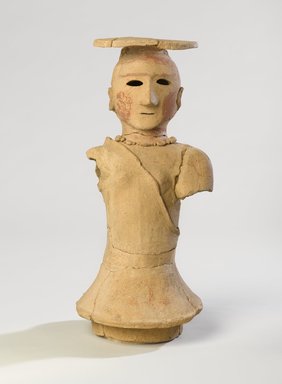
Medium: Earthenware with traces of pigment
Geograhical Locations:
Dates:5th–6th century
Dimensions: 18 x 8 3/4 x 7 1/2 in. (45.7 x 22.2 x 19.1 cm)
Collections:
Museum Location: Asian Galleries, Arts of Japan, 2nd floor
Exhibitions:
Accession Number: 79.278.1
Image: 79.278.1_PS9.jpg,
Catalogue Description: Three-quarter length standing figure of a priestess, who would have presided over the funeral ceremonies of a Yamato chieftain. She wears a coat-like robe closed diagonally across the chest and having a flaring lower edge. She has a string of beads around her neck and a flat, crescent-shaped headdress. Haniwa were placed around and on the top of a kofun (burial mound) for which the period is named. Kofun mounds have been located throughout Japan, from the end of the 3rd century to late 5th-6th century A.D., demonstrating the long duration of the practice. The large mounds are associated with high ranking leaders. Material: Buff earthenware with traces of red iron-oxide pigment on the lower robe, neck, cheeks, eyebrows, and forehead.